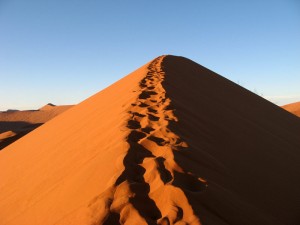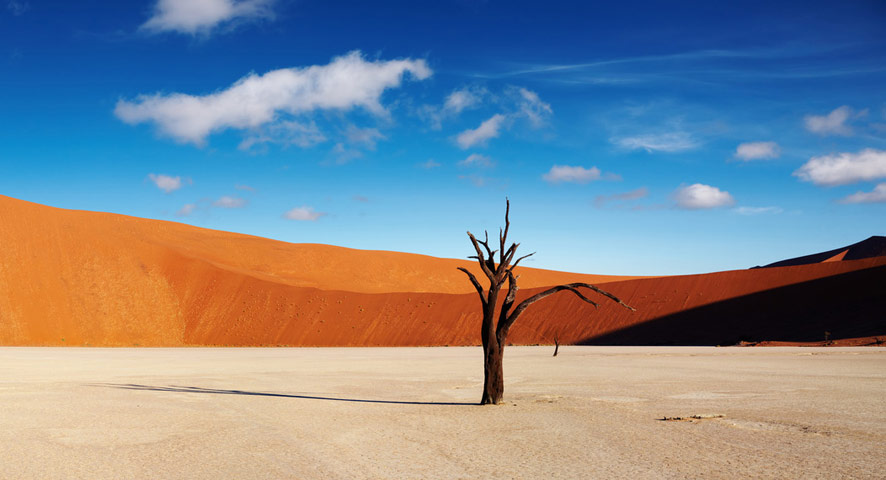Namibia is divided into four major regions. The salt pan of Sossusvlei in Namibia is located in the middle of the Namib-Naukluft Park in the area of the central Namib dunes, which is about 32,000 square kilometers in size. The Namib desert dominates the entire coastline of Namibia between the Kuiseb Canyon in the north and the Koichab River in the south near the harbour town of Lüderitz. In 1979, some areas of the park, including the Sossusvlei were affiliated. The Namib-Naukluft Park was founded by German colonists in 1907. Through the ages of time the park has expanded and it is now the largest national park of Africa with nearly 50,000 square kilometers in size.
The Sossusvlei in Namibia is more than 300 kilometers long and 140 kilometers wide and consists of seemingly endless sand dunes. The meaning of the Nama word for the Namib was derived from this apparent vast emptiness of the vlei. In English it translates to “empty space” or “place where there is nothing”. The spectacular height of these dunes creates a phenomenal attraction to visitors who come to witness the highest dunes in the world situated in the area. These dunes can reach up to 300 meters high and look like an amphitheater surrounding the huge salt pan or “vlei”. “Sossos” translates to “blind river” which is derived from the dried up Koichab river in the area. Experiencing the beauty of the Sossusvlei is a must for Namibia visitors.
In the Namib-Naukluft Park, Sossusvlei with the surrounding Vleis and the Sesriem Canyon, are open to visitors. The entrance gate to the park is located in Sesriem on the eastern edge of the park. Day visitors are allowed to enter the park is from sunrise to sunset. Park guests are welcome to enter and exit as they wish.
The Sossusvlei is located around 96 kilometers from the park entrance. The road to get there was tarred and is in good condition. At the end of the tarred road there is a parking area among camel thorn trees. The last eight kilometers of track is deep soft sand and can be crossed by foot or by four-wheel drive. Alternatively, there is a fee-based shuttle service. The journey from the park entrance to Sossusvlei is about a 90 to 120 minutes drive due to the maximum speed limit of 60 km/h. An entrance free is payed at the gate.
The Dune 45 is besider to “Big Daddy” and “Big Mama”, one of the most famous dunes at Sossusvlei.
The spectacularly beautiful Dead Vlei and Hidden Vlei offer stunning contrasts.
Who would have thought that this plant can be up to 2000 years old? The Welwitschia is a true survivor.
Ballooning over the Namib offers unique views.







